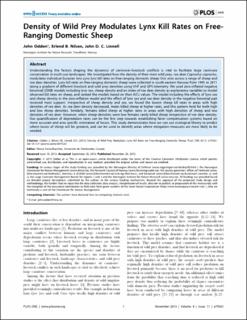| dc.contributor.author | Odden, John | |
| dc.contributor.author | Nilsen, Erlend Birkeland | |
| dc.contributor.author | Linnell, John Durrus | |
| dc.date.accessioned | 2023-07-11T12:11:58Z | |
| dc.date.available | 2023-07-11T12:11:58Z | |
| dc.date.created | 2014-02-20T15:06:22Z | |
| dc.date.issued | 2013 | |
| dc.identifier.citation | PLoS ONE. 2013, 8 (11), . | en_US |
| dc.identifier.issn | 1932-6203 | |
| dc.identifier.uri | https://hdl.handle.net/11250/3077623 | |
| dc.description.abstract | Understanding the factors shaping the dynamics of carnivore–livestock conflicts is vital to facilitate large carnivore conservation in multi-use landscapes. We investigated how the density of their main wild prey, roe deer Capreolus capreolus, modulates individual Eurasian lynx Lynx lynx kill rates on free-ranging domestic sheep Ovis aries across a range of sheep and roe deer densities. Lynx kill rates on free-ranging domestic sheep were collected in south-eastern Norway from 1995 to 2011 along a gradient of different livestock and wild prey densities using VHF and GPS telemetry. We used zero-inflated negative binomial (ZINB) models including lynx sex, sheep density and an index of roe deer density as explanatory variables to model observed kill rates on sheep, and ranked the models based on their AICc values. The model including the effects of lynx sex and sheep density in the zero-inflation model and the effect of lynx sex and roe deer density in the negative binomial part received most support. Irrespective of sheep density and sex, we found the lowest sheep kill rates in areas with high densities of roe deer. As roe deer density decreased, males killed sheep at higher rates, and this pattern held for both high and low sheep densities. Similarly, females killed sheep at higher rates in areas with high densities of sheep and low densities of roe deer. However, when sheep densities were low females rarely killed sheep irrespective of roe deer density. Our quantification of depredation rates can be the first step towards establishing fairer compensation systems based on more accurate and area specific estimation of losses. This study demonstrates how we can use ecological theory to predict where losses of sheep will be greatest, and can be used to identify areas where mitigation measures are most likely to be
needed. | en_US |
| dc.language.iso | eng | en_US |
| dc.rights | Navngivelse 4.0 Internasjonal | * |
| dc.rights.uri | http://creativecommons.org/licenses/by/4.0/deed.no | * |
| dc.title | Density of Wild Prey Modulates Lynx Kill Rates on Free-Ranging Domestic Sheep | en_US |
| dc.title.alternative | Density of Wild Prey Modulates Lynx Kill Rates on Free-Ranging Domestic Sheep | en_US |
| dc.type | Peer reviewed | en_US |
| dc.type | Journal article | en_US |
| dc.description.version | publishedVersion | en_US |
| dc.rights.holder | © 2013 The Authors | en_US |
| dc.source.pagenumber | 8 | en_US |
| dc.source.volume | 8 | en_US |
| dc.source.journal | PLoS ONE | en_US |
| dc.source.issue | 11 | en_US |
| dc.identifier.doi | 10.1371/journal.pone.0079261 | |
| dc.identifier.cristin | 1117177 | |
| cristin.unitcode | 7511,2,0,0 | |
| cristin.unitname | Avdeling for terrestrisk økologi | |
| cristin.ispublished | true | |
| cristin.fulltext | original | |
| cristin.qualitycode | 1 | |

